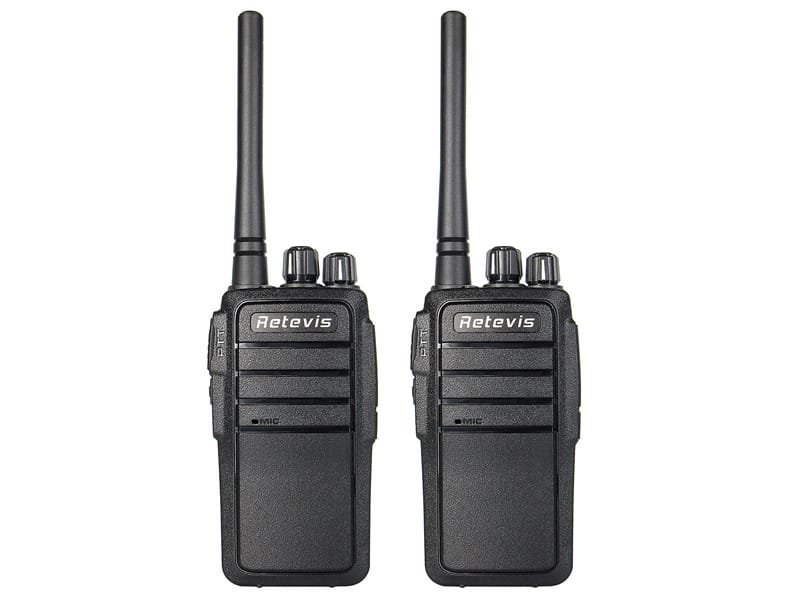What’s your requirements of buy walkie-talkies ? Well that may be the most popular question when you consider to buy it . This time we’ve collected some different people’s ideas for sharing . It may helps to give some reference if you know nothing about how to choose.
1.UHF or VHF
Walkie-talkies that aren’t toys, are not cheap. Whether you’re buying a set of 4 for your Deli or a fleet of 40 for your distribution center, you’ll want to spend wisely to avoid having to live with a mistake. A critical point in choosing the right two-way radio is knowing that UHF is going to be your best bet in most circumstances. Note: UHF radios will never be able to communicate with VHF radios! So, if you already have radios and are looking to purchase additional units to use with them, be sure to select the same band.
UHF radios
(Ultra High Frequency) operate on frequencies from 400 to 512 Megahertz (MHz). UHF radios work best for most two-way radio users because the waves are shorter and can get around or penetrate areas of interference found in buildings, thickly wooded or hilly areas and urban outdoor settings. UHF walkie-talkies with a good-sized antenna and enough power will reach further into a building and push through and around steel, concrete, wood and earth. If your two-way radios are going to be used exclusively indoors or if they’ll need to go indoors and outdoors, UHF is hands down your best choice.Just like the RT21 does .
VHF radios (Very High Frequency) operate between 136-174 MHz. The advantage to a VHF walkie-talkie is that it can cover more distance with less power because VHF waves are longer and remain closer to the ground. Two-way VHF radios work best when there’s a clear line-of-sight between the sender and the receiver with little obstruction. VHF radios are used exclusively in aviation and marine communications where signals are sent across open bodies of water or between the sky and the ground. VHF band walkie-talkies are also great for open fields, golf courses, landscaping and for outdoor security situations with few obstacles.
Typically, VHF antennas are longer than those built into UHF radios because they need to facilitate transmission over longer distances and accommodate the VHF frequency range. Another benefit of VHF waves is that they will penetrate trees and foliage better than UHF radios. However, you will be better served with UHF radios, if you have any plans to use the radios indoors or indoors to outdoors.
But more and more people will choose a dual band radio for wider and more convenient use ,such as this RT5RV.
2.Privacy Codes
That is another things that people will consider when buy walkie-talkies .The Privacy Codes is more like Interference Elimination Codes Privacy Line Codes (PL), Tone, Squelch Codes, Quiet Talk Codes (QT), Interference Elimination Codes. There are more than a few names for them in the two-way radio industry. Privacy codes is the most common name, but interference elimination codes would be more accurate. Though they greatly reduce the odds of your conversation getting stepped on by someone else’s broadcasts; they don’t guarantee privacy. For more detailed information on how privacy codes work visit privacy codesTo communicate using privacy codes, you and the person you’re talking with must have your radios set to the same frequency and the same privacy code e.g. both radios set to Frequency 462.5625, Privacy 13. Depending on the type of radio you buy (analogue or digital) you may have access to between 38 and 121 privacy codes.Multiply the number of privacy codes available for your radio, by the number of frequencies allotted to the type of radio service you use and you’ll have anywhere from 500 to 3,000 or more chances to have an uninterrupted conversation! Just remember that privacy codes increase your odds of not being interrupted, but they don’t guarantee it. If someone within range has their walkie-talkie set to the same frequency and the same privacy code as yours, they could hear and join in your conversation. With so many frequencies and privacy codes the odds are slim, but still present.If someone has their radio set to the same frequency, but not the same privacy code they will be able to hear your conversation, but they won’t be able to join in.
Analogue two-way radio privacy codes range from 1-38. In general, manufacturers use them in a standardized way allowing for radio compatibility across brands.
Digital two-way radio privacy codes are numbered from 39 and can go as high as 99, 121 or higher. However, digital privacy codes don’t always map across manufacturers, so your digital two-way radios, with digital codes, may not be able to communicate using privacy codes with radios made by other manufacturers.
……
I think you may got more details to think about when you buy walkie-talkies ,so why not share your comments below to let more people learn here?
Welcome all your comments .
Views: 2




That was probably the best explanation of the difference of REPRESENTATIVES I’ve heard in a while. Great job!
Thanks ! You could also share your minds here 🙂